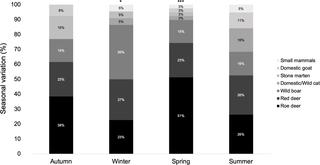PLOS ONE ( IF 3.7 ) Pub Date : 2020-03-31 , DOI: 10.1371/journal.pone.0230433 Ana M Figueiredo 1 , Ana M Valente 1, 2 , Tânia Barros 1 , João Carvalho 1 , Davide A M Silva 1 , Carlos Fonseca 1 , Luís Madeira de Carvalho 3 , Rita Tinoco Torres 1

|
The Iberian wolf (Canis lupus signatus) is a top predator that inhabits the Iberian Peninsula. In Portugal, its numbers and distribution declined throughout the 20th century, due to human persecution, habitat degradation and prey decline, which have led to higher predation rates of livestock in the remaining packs. In Montesinho Natural Park (northeast Portugal), wild ungulate populations have been increasing in the last years, which may have led wolf to predate upon them. In order to assess Iberian wolf diet in this area, 85 wolf scats were collected from transects distributed throughout the study area in two periods between November 2017 and August 2019. Scat analysis indicated a high predation on wild ungulates, where the frequency of occurrence showed that roe deer was the most consumed prey (44%), followed by red deer (26%) and wild boar (24%). Domestic/wild cat (6%), domestic goat and stone marten (5%) were consumed in lower quantities. It was found a higher selection towards roe deer (D = 0.71) and this was the only prey item which was significantly dependent of the season of the year (χ2 = 16.95, df = 3, p < 0.001). This is the first study in Portugal where was recorded that wolves feed mainly on wild ungulates. We conclude that lower livestock predation may be correlated with higher wild ungulates densities in our study area, as well as suitable husbandry practices, leading to a shift on Iberian wolf diet from mainly livestock on previous studies to wild ungulates.
中文翻译:

狼吃什么?在葡萄牙东北部评估濒临灭绝的伊比利亚狼(Canis lupus signatus)的饮食。
伊比利亚狼(Canis lupus signatus)是居住在伊比利亚半岛的顶级捕食者。在葡萄牙,其数量和分布在整个20世纪都在下降一个世纪以来,由于人类的迫害,栖息地的退化和猎物的减少,导致了其余种群中牲畜的捕食率更高。在最近的蒙特塞尼奥自然公园(葡萄牙东北部),野生有蹄类动物的数量一直在增加,这可能导致狼早于它们。为了评估该地区的伊比利亚狼饮食,在2017年11月至2019年8月的两个时期中,从分布在整个研究区域的样地中收集了85只狼粪。粪便分析表明,野生有蹄类动物的捕食率很高,其发生频率表明consumed鹿是最消耗的猎物(44%),其次是马鹿(26%)和野猪(24%)。家猫/野猫(6%),家山羊和石貂(5%)的消费量较低。发现对towards的选择更高(D = 0。2 = 16.95,df = 3,p <0.001)。这是葡萄牙的第一项研究,据记录,狼主要以有蹄类动物为食。我们得出的结论是,在我们的研究区域中,较低的牲畜捕食性可能与较高的野生有蹄类动物的密度以及适当的饲养方式有关,从而导致伊比利亚狼的饮食从以前研究的主要牲畜转向野生有蹄类动物。



























 京公网安备 11010802027423号
京公网安备 11010802027423号